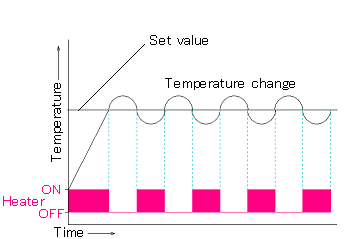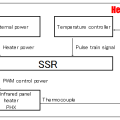
If the current temperature is lower than the set value, turn on the heater to heat.
When it becomes higher than the set value, turn off the heater and cool naturally.
The control method that keeps the temperature constant by turning the heater on and off in this way is called ON-OFF operation.
In addition, since the operation amount operates at two values of 0% and 100% from the set value, it is also called 2-position operation.
The advantage of ON-OFF control is that the configuration is simple and inexpensive.
The disadvantage is that in ON-OFF control, the output is turned on and off by the set value, so the output may frequently turn on and off (chattering) even with a slight temperature change at the boundary surface.
As a result, the life of the output relay is shortened and the connected equipment is adversely affected.
To prevent this, on models where the control cycle can be freely fixed, chattering is prevented by making one cycle longer.
Another measure is to provide a clearance (hysteresis) between the ON and OFF operations.
Hysteresis control is explained in the next section.
 HEAT-TECH Best Technology Online Shop
HEAT-TECH Best Technology Online Shop 








